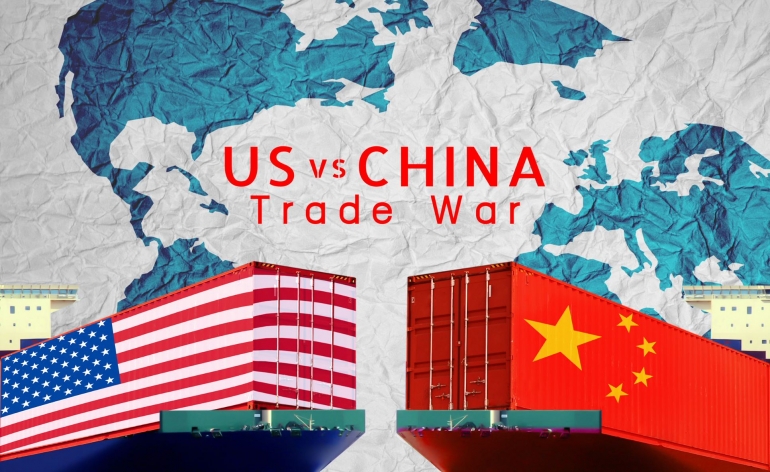Fri 06 April 2018
By Professor Heng Wang
China has imposed retaliatory duties on US food imports including pork, fruit, nuts, and wine of up to 25 per cent as a response to President Trump’s tariffs on steel and aluminum imports under Section 232. This is a real trade war between the United States and China in forty years of China's opening-up and the first time that both nations have taken measures. Is the 2018 trade war similar to previous ones? The answer seems to be yes, but mostly no. It will be helpful to analyze the history of U.S.-China trade frictions to better understand the 2018 trade war.
Since the early 1990s, the United States and China were close to trade war in 1991, 1995, 1996 and 2002 that were caused by intellectual property and steel issues. On May 26, 1991, the Special 301 investigation was initiated by the United States Trades Representative (USTR). The United States threatened to impose sanctions on China under Section 301 should China fail to provide sufficient protection for U.S. intellectual property–related products. China also announced the intention of counterretaliation. Eventually, both sides managed to reach last-minute agreements: the United States withdrew the threatened sanctions against Chinese exports, and China would not take counterretaliation. The saga was largely the same regarding possible Sino-US trade wars in 1995 and 1996.
In 2002, the trade friction was different from previous ones in at least two aspects. One was it was triggered by steel rather than intellectual property. The other was it involved not only the United States and China, but also other WTO members. It concerned the U.S. definitive safeguard measures on imports of certain steel products, targeting the steel products from other WTO members such as the European Communities. These measures were the outcome of a safeguard investigation under Section 201 of the Trade Act of 1974 to determine whether certain imported steel products were being imported in such increased quantities as to be a substantial cause of serious injury, or the threat thereof, to the U.S. domestic industry producing products like or directly competitive with the imported products. These U.S. measures led to a WTO dispute, which was also the first WTO case China participated in after its WTO accession. Notably, China notified the WTO of the list of U.S. products that China planned to suspend concessions. Eventually, the United States failed in this case and terminated all the safeguard measures in question. The US-China trade war was once again avoided.
What can we learn from history? On the one hand, the current trade war is similar to previous friction particularly that of 2002 in a general sense. They involve steel, a sensitive industry in trade. They also involve the threat of a tit-for-tat approach, which possibly incentived trade negotiations.
On the other hand and more importantly, they are very different. First, the 2018 trade war is a real and much more serious one compared with the previous trade frictions. In the past, trade wars did not happen as the United States did not take measures due to the last-minute agreements with China or due to the WTO ruling. Second, this trade war was triggered by Section 232 measures rather than Section 201 ones, which could be more “dangerous”. The former appears to give the U.S. government more room in practice, and is subject to less checks due to the vagueness of national security. Third, the previous frictions during 1991-1996 did not involve WTO norms, but China has referred to WTO Safeguard Agreement in counterretaliation. It seemed that the WTO rules still play an important role. Fourth, 2018 trade war has much more profound negative impacts on bilateral trade between two superpowers, and on the multilateral trading system. This is more difficult for the WTO given the challenges arising from its insufficient Appellate Body members. It would be wise to stop it and reduce its adverse effects.
This is not the end of the story. China responded to the U.S. possible measures following Section 301 investigations (a proposed list of tariff increases on Chinese imports) by, inter alia, the dispute settlement at the WTO. In any respect, the role of the WTO deserves a lot of attention here to maintain a rule-based multilateral trading system. It is much easier to dismantle the system than build it.
Note: The author is grateful to Professor Guohua Yang of Tsinghua University Law School for the helpful discussion.
2018年中美贸易战与之前1991年、1995年、1996年 以及 2002年中美贸易摩擦既有相同,但更有不同。相同之处包括这种摩擦事实上成为一种策略,有可能最后促成双方进行贸易谈判。不同之处则在于,其一,2018年中美贸易战更为严重。美方已采取了一些关税措施(美国对进口钢铁和铝产品加征关税,即232措施),中方采取了相应措施。 而此前双方并未将相关措施付诸实践,而是达成相关协议。其二,2018年中美贸易战中,美方采取了第232条措施(Section 232),而非过去常常涉及的第201条措施(Section 201)。前者涉及更为敏感和模糊的国家安全问题,具有更大不确定性,对国际贸易规则体系危害更大。其三,2018年中美贸易战涉及WTO条款,之前的摩擦并未援引。第四,2018年中美贸易战关涉WTO体制的未来,其法律问题更为复杂棘手,且WTO争端解决本已面临困境(上诉机构成员因美国反对“人马不齐“),这带来巨大挑战。2018年中美贸易战需要各方冷静思考,维护以规则为基础的多边贸易体制至关重要。“破坏规则易,维护规则难”。
作者感谢清华大学杨国华教授提出的宝贵意见。
